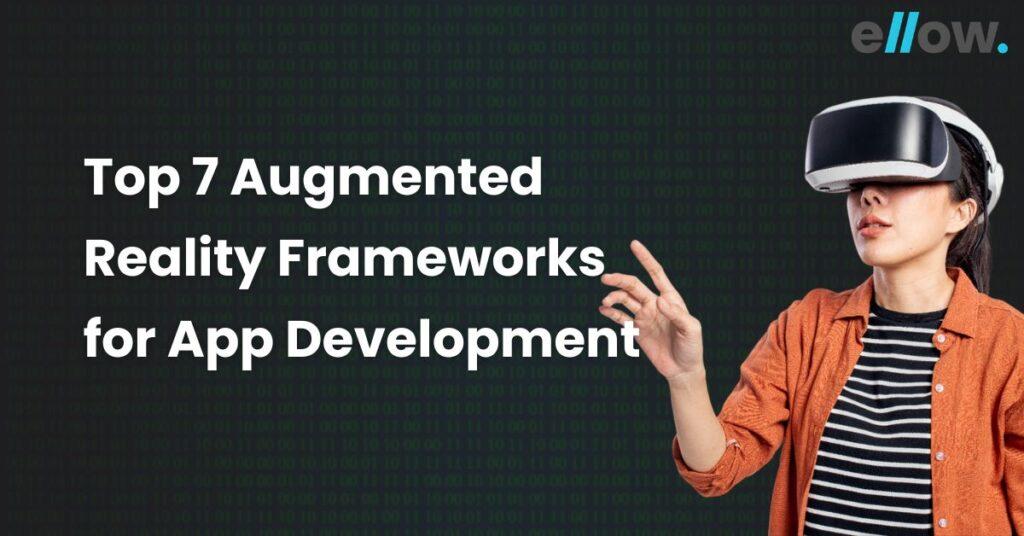
Blog
Top 7 Augmented Reality Frameworks for App Development

- Sariga Gopalan
- June 24, 2023
- 10:47 am
Augmented Reality (AR) has revolutionized the app development landscape, transforming how we engage with digital content. By seamlessly blending virtual elements into the real world, AR elevates our experiences and unlocks many possibilities across diverse industries.
This article will delve into AR, its frameworks, and its impact on various sectors.
Table of Contents
What is Augmented Reality?
The statistics say that by 2024, there will be an estimated 1.7 billion mobile augmented reality (AR) user devices worldwide.
AR blends virtual objects with the real world, providing users with enhanced and interactive experiences. Unlike Virtual Reality (VR), which creates entirely immersive digital environments, AR supplements our physical surroundings with virtual elements.
AR can be widely used in gaming, entertainment, education, healthcare, retail, and manufacturing applications.
From games that overlay virtual characters onto real environments to educational apps that bring historical artifacts to life, AR has enhanced user engagement and immersion.
Additionally, industries like architecture and interior design have adopted AR to visualize and present their concepts to clients more interactively and realistically.
To develop AR applications, developers rely on augmented reality frameworks. These frameworks handle complex tasks such as tracking the real world, recognizing objects or images, and rendering virtual elements seamlessly.
Importance and applications of AR in various industries
In Education
- AR enhances traditional learning methods by providing interactive, engaging, and immersive experiences for students.
- By overlaying virtual content onto textbooks, classroom materials, or real-world objects, AR allows students to visualize and understand complex concepts more easily.
In Healthcare
- AR revolutionizes medical training by providing real-time visualization of anatomical structures during surgeries or complex procedures.
- Surgeons can use AR overlays to enhance precision, minimize risks, and improve surgical outcomes.
- Medical students can practice procedures on virtual patients, gaining valuable experience before working with real patients, which enhances their skills and confidence.
In Entertainment and Gaming
- AR offers a new level of interactivity and immersion in entertainment experiences, blurring the lines between the virtual and physical worlds.
- Games like Pokémon Go have demonstrated the mass appeal of AR, engaging millions of users worldwide.
Innovation and User Experience
- The seamless integration of virtual and physical realms in AR opens up endless possibilities for innovation and creativity across industries.
- AR enables the development of new applications, services, and products that enhance user experiences and interactions with information and surroundings.
Kudan
Kudan is an AR framework known for its robust tracking capabilities and versatile features. It offers both marker-based and marker-less tracking. Kudan stands out with its SLAM (Simultaneous Localization and Mapping) technology, enabling precise positioning of virtual objects in the real world.
This framework is ideal for gaming, education, and industrial training applications. However, it might lack some advanced features found in other frameworks.
Let’s see some areas where Kudan is in use:
- Industrial Training and Maintenance: Kudan’s SLAM technology helps in overlaying virtual instructions, annotations, or step-by-step guides onto real machinery or equipment, and workers can receive real-time visual cues and guidance in industrial training.
- Architecture and Construction: Using Kudan, virtual models of buildings, structures, or interiors can be superimposed onto the physical environment, allowing stakeholders to visualize and assess designs more accurately.
- Gaming and Entertainment: Kudan’s AR technology helps developers can create AR games that blend virtual characters, objects, and environments seamlessly with the real world.
- Navigation and Wayfinding: Kudan’s SLAM technology enables accurate indoor and outdoor navigation experiences. By overlaying digital directions, markers, or visual cues in the real world, users can easily navigate unfamiliar environments.
Apple's ARKit & RealityKit
ARKit, developed by Apple, is a powerful framework exclusively for iOS devices. It offers motion tracking, object recognition, and face tracking. ARKit integrates with RealityKit, and creates a framework for creating 3D content, providing developers with advanced rendering capabilities and realistic simulations.
Here are some popular uses of Apple’s ARKit & RealityKit:
- Healthcare and Medical Training: ARKit and RealityKit use AR to overlay medical imaging data, such as CT scans or X-rays, onto the patient’s body during procedures, improving accuracy and precision. Medical students can benefit from interactive anatomy lessons, where virtual 3D models are superimposed onto physical specimens, enhancing learning experiences.
- Education and Training: They have immense potential in education and training applications. With ARKit, educators can create interactive learning materials that overlay digital content, such as 3D models, annotations, or videos, onto physical textbooks or real-world objects.
- Navigation and Wayfinding: ARKit has been instrumental in improving navigation experiences. AR-based navigation apps can overlay digital directions, visual cues, and points of interest onto the real world, providing users with intuitive and context-aware guidance.
Google's ARCore
ARCore is a software development kit (SDK) developed by Google that enables developers to create augmented reality experiences for Android devices. Released in 2017, ARCore swiftly gained traction due to its powerful capabilities and ease of use.
By leveraging the device’s sensors, camera, and processing power, ARCore allows virtual content to be seamlessly integrated into the user’s real-world environment.
This technology is used across various sectors, including gaming, education, retail, and architecture.
- Gaming and Entertainment: ARCore has transformed the gaming landscape by allowing developers to create immersive AR games. From location-based AR games like Pokémon GO to tabletop gaming experiences. ARCore’s precise tracking and environmental understanding capabilities enhance gameplay and provide users with unique entertainment options.
- Industrial and Enterprise Applications: ARCore finds applications in industrial training, maintenance, and remote assistance. It enables overlaying digital instructions, annotations, or real-time sensor data onto physical equipment or machinery, aiding workers in complex tasks, reducing errors, and enhancing safety.
- Architecture and Design: ARCore is a valuable tool for architects and interior designers, enabling them to visualize and present their designs in the real world.
Vuforia
Vuforia is a versatile AR platform that supports marker-based and markerless tracking. It provides developers with tools for object recognition, virtual buttons, and occlusion, allowing virtual objects to interact with the real world seamlessly.
Vuforia’s compatibility with popular development tools like Unity and Unreal Engine makes it a preferred choice for AR app developers.:
- Product Visualization and Marketing: With Vuforia, businesses can create interactive AR experiences that allow customers to virtually visualize and explore products before making a purchase. By overlaying digital content, such as 3D models, animations, or product information, onto physical items or packaging, customers can get a better understanding of the product’s features, functionality, or customization options.
- Retail and E-commerce: Vuforia revolutionizes the AR shopping experience. By overlaying virtual try-on capabilities, customers can virtually try on clothes, accessories, or cosmetics, eliminating the need for physical trials. Vuforia’s advanced object recognition and tracking ensures accurate placement and alignment of virtual objects, enhancing the realism and usability of AR shopping applications.
- Museums and Cultural Heritage: Vuforia’s AR technology has been adopted by museums and cultural institutions to provide interactive and informative experiences to visitors. Uses digital content, such as historical reconstructions, multimedia information, or interactive guides, onto exhibits or artifacts, Vuforia enhances visitor engagement and understanding.
Unreal Engine
Unreal Engine is a powerful game engine that offers built-in AR development capabilities. Developers can create high-quality and immersive AR experiences. The Engine provides advanced features such as realistic physics simulations, complex lighting, and 3D model integration.
Unreal Engine’s flexibility and scalability make it suitable for creating AR apps across multiple platforms.:
- Virtual Prototyping: Unreal Engine provides a platform for creating virtual prototypes of products, environments, and user interfaces. It allows designers and engineers to visualize and test their concepts before investing in physical prototypes, leading to cost and time savings.
- Marketing and Advertising: Unreal Engine enables the creation of interactive and engaging marketing experiences. It allows advertisers to develop virtual showrooms, product visualizations, interactive demos, and branded experiences that captivate and engage consumers.
- Serious Games: Unreal Engine is utilized in the development of serious games, which are designed for purposes beyond entertainment, such as education, healthcare, and training. These games can simulate real-world scenarios, aid in rehabilitation, or enhance learning experiences.
AR.js
AR.js is an open-source JavaScript library that allows developers to create AR experiences directly by web browsers. With AR.js, users can access AR content without installing additional applications.
This framework supports marker-based and markerless tracking and is compatible with various devices and browsers. AR.js simplifies web-based AR development and enables widespread accessibility.
- Advertising and Marketing Campaigns: Brands can leverage AR.js to create interactive and memorable experiences, such as AR product demos, virtual try-on, AR scavenger hunts, or branded AR filters for social media platforms.
- Art and Entertainment: AR.js can be used in the creation of interactive art installations and exhibitions. Artists can combine physical art pieces with virtual elements, animations, or audio to create immersive and dynamic experiences. It can also be used in the entertainment industry for interactive storytelling, AR performances, or virtual characters.
- Training and Simulations: AR.js can provide a cost-effective solution for training and simulations in various industries. It can be used to overlay step-by-step instructions, visual cues, or virtual guides on real-world objects, helping trainees to learn complex procedures or operate equipment more effectively.
Wikitude SDK
Wikitude SDK is a widely used AR software development kit that provides marker-based and markerless tracking, image recognition, and 3D model rendering tools. It offers a user-friendly interface and supports iOS, Android, and Windows platforms. Wikitude SDK’s simplicity and flexibility make it a popular choice for developers looking to create AR applications quickly.
The framework enables developers to easily detect and track markers in the user’s environment, such as QR codes or custom-designed markers. This functionality allows for precise positioning and alignment of virtual content onto real-world objects, enhancing the realism and immersion of AR experiences.
- Social AR Experiences: The Wikitude SDK enables developers to build social AR applications, allowing users to share and interact with AR content in real time. This can include collaborative AR games, shared AR annotations, or AR filters for social media platforms, enhancing social interactions and engagement.
- Event and Exhibition Experiences: The Wikitude SDK can be used to create AR experiences for events and exhibitions. Visitors can use their mobile devices to access additional information, interactive maps, or virtual guides overlaid onto exhibits, enhancing their engagement and understanding.
- Advertising and Marketing Campaigns: Brands can create AR experiences that allow users to interact with products, view virtual try-on, or participate in AR-based promotions, providing a unique and engaging marketing experience.
- Medical and Healthcare Applications: The Wikitude SDK has applications in the medical and healthcare fields. It can be used for anatomy education, patient visualization, or medical procedure guidance. AR overlays can provide real-time information, visual aids, or instructional guides for healthcare professionals.
Final thoughts
In conclusion, Augmented Reality has emerged as a game-changing technology in app development, revolutionizing user experiences across industries. With the right AR framework, developers can leverage the power of AR to create immersive and interactive applications.
Whether you choose Kudan, Apple’s ARKit & RealityKit, Google’s ARCore, Vuforia, Unreal Engine, AR.js, or Wikitude SDK, selecting the appropriate framework is crucial for delivering exceptional AR experiences to users.
Sariga Gopalan
Sariga Gopalan
Recent posts


Latest technologies in the software industry






